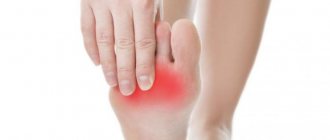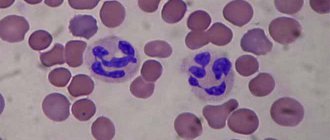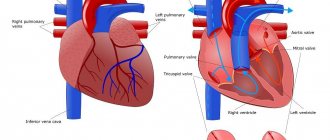The essence of vegetative-vascular syndrome
Of course, vegetative-vascular dystonia during pregnancy is an undesirable condition due to such an important stage in a woman’s life when her body works simultaneously for two people. The disease can be characterized by the incorrect functioning of the autonomic part of the nervous system, which directly affects the quality of work of all organs and systems of the body without exception. It is worth noting that with VSD, violations can occur:
- in the sympathetic part of the nervous system, which activates the heartbeat, relaxes the muscles of the smooth walls of the intestines, and also narrows the arteries;
- in the parasympathetic department, the reactions of which dilate blood vessels, activate the gastrointestinal tract and reduce the heart rate.
The coordinated work of the departments of the autonomic nervous system ensures full regulation of the body to changeable external conditions, the nature and duration of work. A pathological condition that is associated with a disorder of one of the parts of the autonomic nervous system is not considered a disease as such. However, dysfunction identified in pregnant women can affect the condition of both the mother and the fetus. Therefore, if the syndrome is identified, you should not hesitate with treatment procedures.
About symptoms
Vegetative-vascular dystonia has a number of symptoms, one of which is increased or decreased temperature. In general, the main signs of vegetative-vascular dystonia can be divided into the following options:
1. With the hypertensive variant of vegetative-vascular dystonia, the following is observed:
- blood pressure increases;
- headaches appear;
- the person’s face turns red, sweating increases, and the body feels hot;
- a feeling of fear arises, panic attacks occur.
For this variant of the VSD
a low-grade fever is observed, sometimes even the thermometer can show a value above 37.5°C.
2. With the hypotonic variant of VSD, the following is observed:
- blood pressure decreases;
- dizziness begins, fainting is possible;
- the person feels lethargic and weak;
- there is a feeling of coldness in the hands and feet;
- the skin takes on a pale appearance.
In this case, a decrease in body temperature is generally observed.
3. With the cardiac variant of the vegetative-vascular system, a person feels:
- heart pain;
- interruptions are felt when the heart functions.
For this variant of the VSD flow, temperatures of 37 and higher are possible.
4. With a mixed version of VSD, various signs listed above are observed. The temperature may rise or fall.
Thus, if it changes for no reason and if you have one or more of the symptoms listed above, you should definitely visit a doctor.
In addition, low-grade fever with VSD without signs of a cold in nature differs in the following:
- It can increase with even slight physical activity.
- If a person lies down and rests a little, the temperature will return to normal.
- When a person sleeps, the temperature is normal or even lower. You can check this.
- It increases only during the daytime.
If a person does not have a cold, the temperature begins to rise as soon as he wakes up and gets up, then this means VSD! Low-grade fever is observed only in the daytime and over a long period.
To determine the exact cause of the temperature change, visit your doctor.
Main causes of the syndrome
Typical symptoms will tell you about the onset of the disorder. Increasing nervousness, mood swings, tearfulness and severe irritability accompany almost any pregnancy. The causes of dysfunctions of nervous regulation can be:
- addiction to smoking;
- pathological dependence on coffee;
- latent course of infectious diseases;
- insufficient physical activity;
- insomnia;
- accumulated fatigue.
It is worth noting that the transformation of the body at the physiological level during pregnancy occurs throughout all trimesters, and every woman can face the unpleasant diagnosis of “vsd”. However, careful attention to health will help to start treatment in a timely manner and minimize the consequences of the syndrome for the pregnant woman and the fetus.
Serious risks of developing pathology come from hereditary predisposition, brain injury, hormonal changes, as well as chronic diseases of the endocrine system.
Causes of low-grade fever
The causes of low-grade fever, as well as febrile and pyretic, are associated with changes in the functioning of the limbic-hypothalamoreticular system of the body. Simply put, temperature is regulated in the hypothalamus, which acts as a thermostat. Endogenous or exogenous pyrogens cause the release of prostaglandins (inflammatory mediators), and they act on the neurons responsible for thermoregulation, which are located in the hypothalamus. And the hypothalamus generates a systemic response, and as a result, the body is set to a new temperature level.
In what diseases is low-grade fever observed for a certain period of time? The list of such diseases is very extensive and includes:
- infectious diseases - influenza, ARVI, tuberculosis, typhoid, brucellosis, malaria, psittacosis, mononucleosis, Epstein-Barr herpesvirus, cytomegalovirus, rotavirus gastroenteritis and gastroenterocolitis, tick-borne borreliosis (Lyme disease), HIV, urogenital infections, etc.;
- parasitic diseases (helminthic infestations, giardiasis, leishmaniasis, toxoplasmosis);
- sluggish inflammatory processes in chronic rhinitis, sinusitis, sinusitis or tonsillitis; with inflammation of soft tissues (boils, abscesses); with focal pneumonia and lung abscess; for chronic cholecystitis, pancreatitis, cystitis, prostatitis, pyelonephritis, etc.;
- thyroid dysfunction (initial stages of hyperthyroidism, hypothyroidism, thyrotoxicosis);
- systemic immunological diseases - systemic lupus erythematosus, sarcoidosis, giant cell temporal arteritis (Horton's disease), rheumatoid arthritis, granulomatous enteritis (Crohn's disease), Wegener's granulomatosis, ankylosing spondylitis, Sjögren's syndrome;
- tissue necrosis, which can occur as a result of the destruction of red blood cells (hemolysis) during cerebral hemorrhage, myocardial infarction, after surgery, with compartment syndrome, etc.;
- allergic reactions of various etiologies;
- metabolic disorders (gout, porphyria, etc.);
- thromboembolic processes (deep vein thrombosis, pulmonary embolism, etc.).
Main symptoms
Don’t be needlessly nervous and look for diseases out of the blue. Vegetative-vascular syndrome can have the widest and most varied symptoms, which is due to the localization of peripheral nerve endings. However, the characteristic features are:
- periodic dizziness;
- fainting;
- numbness (paresis) of fingers and limbs;
- loss of vitality;
- pain in the heart area;
- increased sweating.
Hypertensive type VSD syndrome (high blood pressure) is characterized by swelling and sweating. With low pressure, VSD reveals itself through possible fainting, weakness, apathy and anemia.
It is important to remember that dysfunction of nervous regulation can affect the functioning of various organs and manifests itself in the following symptoms:
- nausea, heaviness and pain in the stomach;
- chills or trembling, periodically appearing without the presence of ARVI;
- breathing disorders: rapid rhythm, shortness of breath and difficulty in taking deep breaths and exhales;
- libido (sexual desire) disorders.
Anemia and low-grade fever
Anemia and low-grade fever are quite closely related to each other at the biochemical level. Iron deficiency anemia leads to a disruption in the production of hemoglobin and a decrease in its content in red blood cells that carry oxygen to the cells. And with a lack of oxygen in all cells of the body and, first of all, the brain, the metabolic process is disrupted. Therefore, in addition to all other signs of iron deficiency in the body, a slight increase in body temperature is quite often observed. Children and adolescents during puberty are most prone to iron deficiency anemia. In addition to low-grade fever, they often develop colds, and their appetite and body weight may decrease.
In addition, poor iron absorption is associated with a lack of vitamin B9 (folic acid) and vitamin B12 (cyanocobalamin), which regulate hemoglobin synthesis in the bone marrow. And such anemia is called pernicious.
Precision anemia and low-grade fever - if not paid attention to - can lead to the development of inflammation and atrophy of the mucous membranes of the gastrointestinal tract.
Treatment approaches
Often the pathological syndrome returns during pregnancy against the background of exacerbation of teenage diseases and hormonal changes. The difficulty is that treatment cannot include conventional medications to avoid harm to the fetus. To get rid of the problem, vitamin complexes, mild sedatives (valerian), and vascular drugs are prescribed.
Much more important in VSD is the rational organization of sleep and wakefulness. It is important to maintain moderate physical activity and spend time outdoors. Avoid excessive emotional stress or heavy physical work.
However, you should not deny your body physical activity at all. Various features of the course of the syndrome require special methods of influence.
- For problems with low blood pressure, it is recommended to include coffee, dark chocolate, buckwheat, legumes and dairy products in your diet. Slow walking and dancing will help relieve stress.
- High blood pressure allows you to engage in hiking or swimming. It is worth eating lean meat, dairy products, vegetable oils, fruits and cereals.
- Physical activity for cardiac type VSD includes light games of badminton and swimming.
Depression and anxiety
Health - anxiety - depression. Here is a chain of three human states that can transform into one another under certain circumstances.
Both anxiety and depression can be of two types:
-related to external, situational factors (reaction to the world around us, taking into account one’s own perception of this world)
-associated with the internal biochemical processes of the body, so-called endogenous anxiety and depression.
In each disease state, both anxiety and depression are present, their percentage ratio differs. Let's consider the stages of development of a disease associated with external factors. In a stressful situation, anxiety arises - this is the activation of the body aimed at solving the problem. In the event of an attack, a mechanism is activated aimed at repelling aggression or escaping. If the stress is prolonged or very strong for a given individual, the body goes into an energy-saving mode - into depression. This is how he protects himself from energy exhaustion and death. During the depression phase, all energy-intensive functions are switched off: memory decreases, the thought process slows down, motor activity decreases, a person spends more time in a horizontal position, sexual function decreases, etc.
But not all depression looks like this. There is, for example, the so-called “smiling depression”. The presence of depression can sometimes be guessed only by accompanying symptoms, symptoms that are closely related to both anxiety and depression. These include various chronic pains, panic attacks, sleep disorders, and various vegetative symptoms.
The path to depression goes through the following stages: health - anxiety - depression. When treating depression, returning to health goes through the same stages: depression - anxiety - health. This is very important to know, because... at the beginning of therapy, it is necessary that the anxious period be minimal and proceed painlessly and harmlessly for the patient. Therefore, treatment should be carried out under the strict supervision of a neurologist-vegetologist with the obligatory possibility of feedback from the patient and the ability to adjust the treatment.
With endogenous anxiety and depression, the body goes through the same stages, but often more rapidly and more pronounced, which requires faster inclusion of therapeutic measures.
When is it necessary to urgently contact a neurologist-vegetologist?
- If anxiety and depression are accompanied by feelings of sadness,
- If you have suicidal thoughts,
- If the anxiety-depressive state lasts more than 5 days,
- If, against the background of an emotional disorder, somatic complaints appear and increase,
- If you have severe sleep disturbances,
- If emotional disturbances interfere with social functioning.
The symptoms of vegetative-vascular dystonia are extremely diverse and are classified into several main groups. In this material, I propose to discuss in more detail how these signs can manifest themselves, but more on this below, but for now a little general information.
Autonomic neurosis is a secondary name for the disease and can be observed in parallel with a large list of diseases. It happens that the problem manifests itself individually, without the obvious “help” of another serious ailment.
The human nervous system, or rather its “structural subdivision”, whose task includes total control and maintenance of the normal functioning of all internal organs, is called vegetative. Fundamentally, it can be divided into two key departments:
1. Sympathetic - which is entrusted with an extensive list of responsibilities. He is responsible for many things, especially it should be noted:
- relaxation of the muscles of the entire digestive tract, bladder
- rapid heartbeat
- increase in the force of contraction of the heart muscle
- narrowing of almost all arteries and veins in the body
2. The main task of the parasympathetic is the timely contraction of the muscles of the digestive tract.
When the normal balance is disturbed, the balance shifts to one side or another, a condition occurs that is called autonomic dystonia.
Symptoms of autonomic system disorder and classification of dystonia
The symptoms of this unpleasant condition directly depend on the type of dystonia. There are:
- dystonia of the hypotensive type, the symptoms of which are: excessive fatigue and lethargy, fatigue, weakness, dizziness, coldness, numbness of the lower and upper extremities or fingers;
- dystonia of the hypertensive type, the symptoms of which are: pressure surges, imbalance, pain in the heart and stomach, a feeling of lack of oxygen, shortness of breath when lifting heavy objects.
Depending on the location of the lesion, the following types of VSD are distinguished in medicine:
- respiratory dystonia, when due to problems with the respiratory system the patient cannot take a deep breath or exhale;
- cardiac dystonia, when the heart hurts and stops, tachycardia, pressure surges, and irregular heartbeat occur;
- sexual dystonia, when, due to the development of prostatitis in men, an erection may remain, but there is no orgasm, while in women the menstrual cycle is disrupted, unpleasant symptoms from the genitourinary system appear, urination is increased, there are signs of enuresis, burning and colic in the genitals;
- thermoregulatory dystonia, when for no reason the legs may go numb or, conversely, feel hot, chills and fever appear with VSD;
- dyspeptic dystonia, occurring with manifestations of flatulence, diarrhea, constipation, nausea, vomiting, malfunction of the gallbladder and liver;
- psychoneurological or cerebral vascular dystonia, when performance decreases, excessive weakness and emotional instability, irritability, headache and constant dizziness, fainting, loss of orientation in an unfamiliar place, excessive aggressiveness, short temper, panic attacks are noted.
Often pills cannot completely eliminate the symptoms of VSD.
Symptoms of dystonia worsen the quality of life. As a rule, they begin to appear against the background of physical activity and heavy lifting, when the heart begins to beat intensely, shortness of breath and signs of arrhythmia appear.
VSD is characterized by insomnia, weakness, and weakness. Even after a long stay in a state of rest, your hands involuntarily begin to tremble, your joints ache, and in moments of anxiety your lower extremities become cold, even if the temperature in the room is quite stable. Heat rushes to the head. The psycho-emotional system becomes unstable. Phobias and fears appear, and urinary incontinence is often observed. Over time, signs of VSD become frequent, intrusive, and long-lasting.
Symptoms of dystonia may be different in women and men. It is influenced by hormonal levels, lifestyle, and bad habits.
The female half with VSD suffers from lack of air even while being on the street, noise and ringing in the ears when tilting the head, and rapid heartbeat. At the same time, the pressure jumps, pulsation in the head and headache, swelling occurs. Additional symptoms of dystonia:
- heartburn, loss of appetite, sudden weight loss;
- loss of performance, staggering;
- swelling of the eyelids;
- burning in the urethral area;
- skin itching;
- unsteadiness of gait;
- the appearance of pigmentation and red, pink spots on the skin of the face and neck;
- excessive sensitivity on the soles of the feet;
- nosebleeds;
- flatulence, diarrhea;
- constipation, bloating of the intestines and abdomen;
- bitterness, dry mouth with VSD.
In men, the symptoms of dystonia are somewhat different. Noted:
- increased sweating in the armpits and palms;
- inadequate perception of everyday situations;
- headache;
- chronic fatigue;
- hand tremors;
- insomnia;
- dissatisfaction with sex;
- frequent urination with VSD.
Problems begin with the gastrointestinal tract: constipation, diarrhea, flatulence. Often, as men age, they suffer from obesity, pancreatitis, and stomach ulcers. It is the stronger sex that is not resistant to diseases of the cardiac system. According to statistics, 30% have been diagnosed with hypertension, heart failure, stroke, and myocardial infarction for 55 years.
High blood pressure with dystonia
Such manifestations of VSD cannot be tolerated. It is important to assess the seriousness of the situation and recognize the problem as early as possible. The autonomic nervous system affects the functioning of the spinal cord and brain, which are responsible for the functions of many systems in the body (the process of hematopoiesis, the transmission of nerve impulses, the supply of oxygen to the brain).
The consequences can be quite serious. Frequently recurring crises of VSD should be a reason to consult a doctor.
Complications and consequences
- Vagoinsular vegetative crisis (characterized by a sharp release of insulin into the blood, increased intestinal motility (rumbling in the abdomen, the urge to defecate), dizziness, a feeling of a sinking heart, chills, numbness of the extremities).
- From the cardiovascular system: hypertension (persistent, prolonged increase in arterial (blood) pressure);
- coronary heart disease (a group of diseases that are characterized by impaired circulation in the arteries, designed to provide the heart muscle (myocardium) with the necessary blood supply);
- angina pectoris (compressive pain behind the sternum);
- stroke (acute cerebrovascular accident);
- heart attack (death of organ tissue due to insufficient blood supply).
- atony (weakening of muscle tone) of the intestine;
- panic attacks (an unexplained, painful attack of severe anxiety and fear);
- urinary incontinence;
When do you need to urgently see a doctor for VSD?
It is unlikely that you can cope with vegetative syndrome on your own if the following symptoms occur:
- panic attacks;
- blood pressure surges;
- dizziness;
- involuntary excessive urination;
- feeling of lack of air, shortness of breath;
- fainting;
- loss of consciousness;
- insomnia and rapid heartbeat with VSD.
Such symptoms require medical attention and a full examination. VSD threatens paresthesia of the lower extremities, stroke, heart attack, heart failure, hypertensive (hypotonic) crisis.
Particularly dangerous is a mixed pseudoaddisonian crisis, when symptoms begin to appear in aggregate and last more than 1 hour. It is impossible to ignore such psychosomatic manifestations of dystonia if there is poor orientation in space, attention and memory have deteriorated. This can lead to serious problems, disability and other negative consequences, including death. Here's what you need to remember when neglecting to visit doctors when the symptoms of dystonia become obvious.
What is dystonia and why does it develop, you can find out from the video:
A lot of interesting information about VSD and its symptoms can be obtained from the video below:








